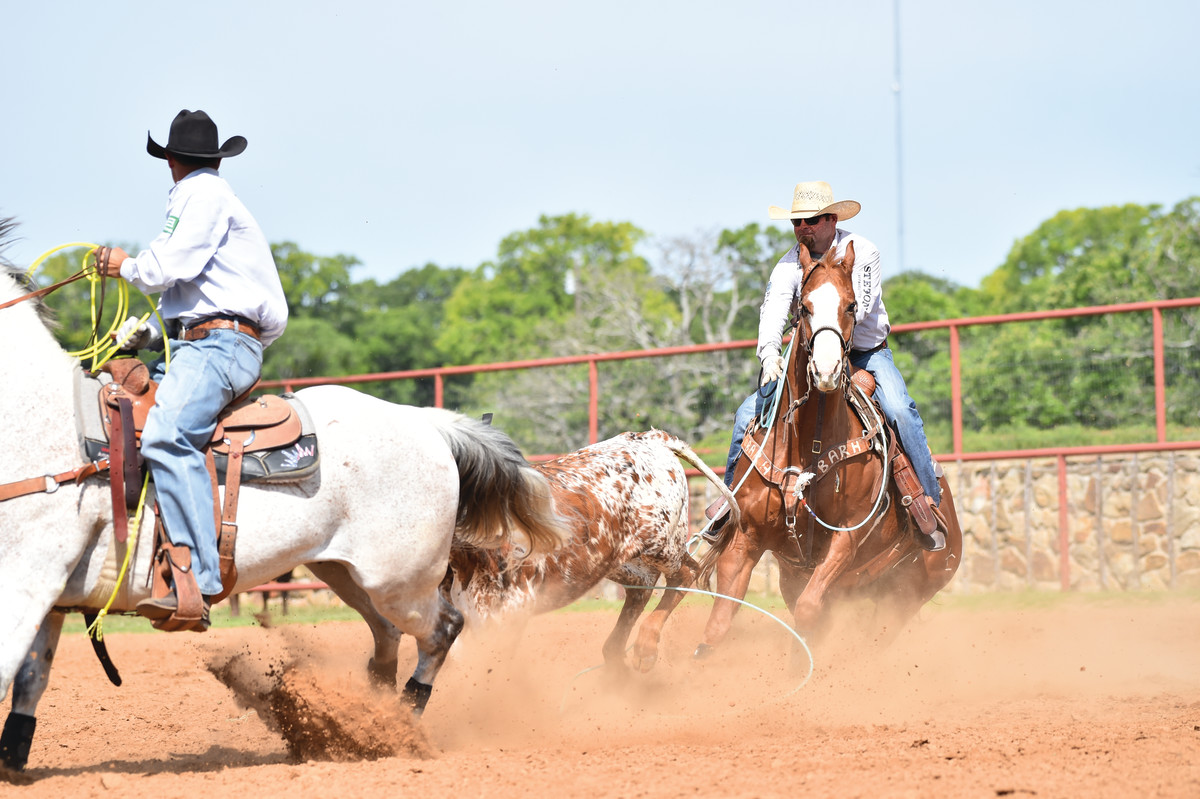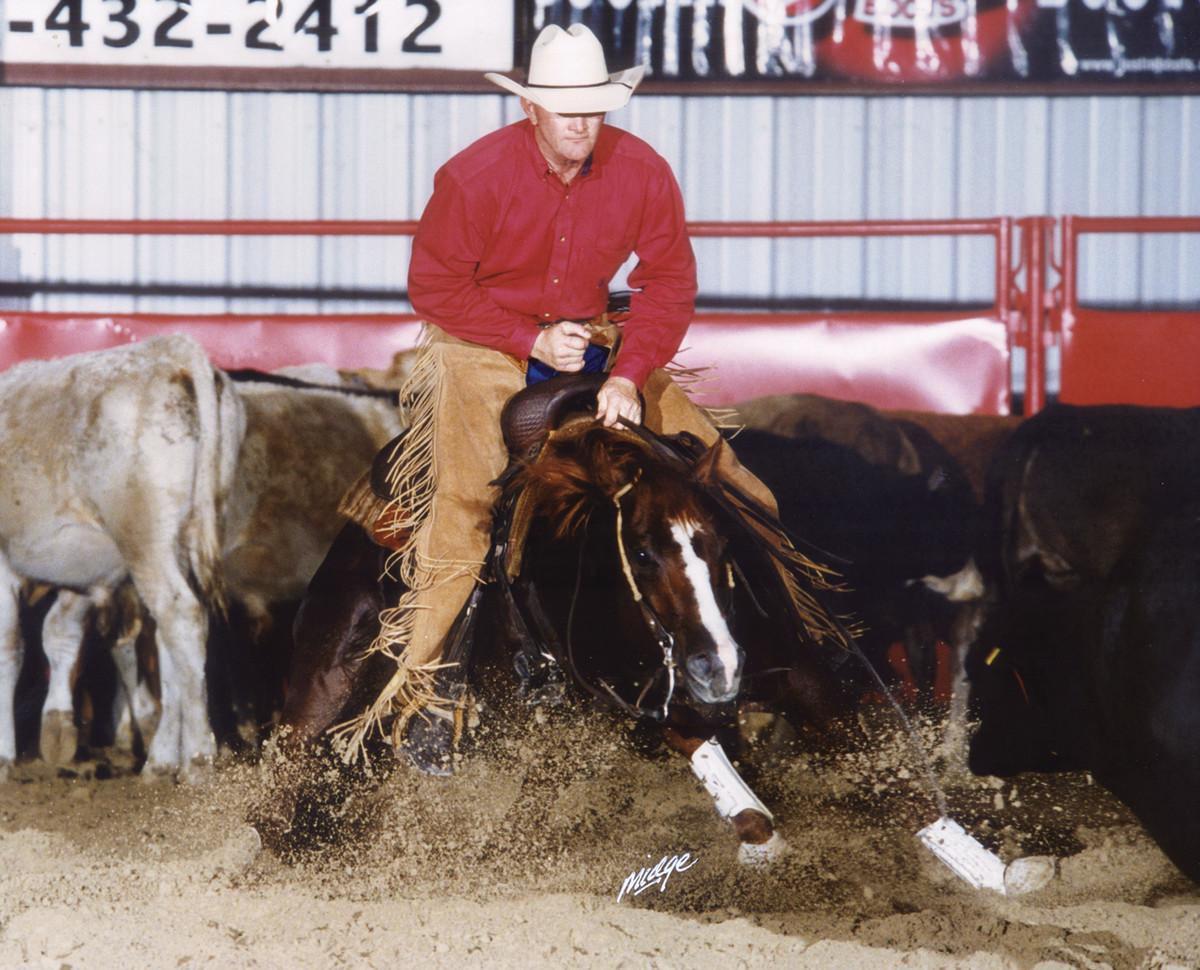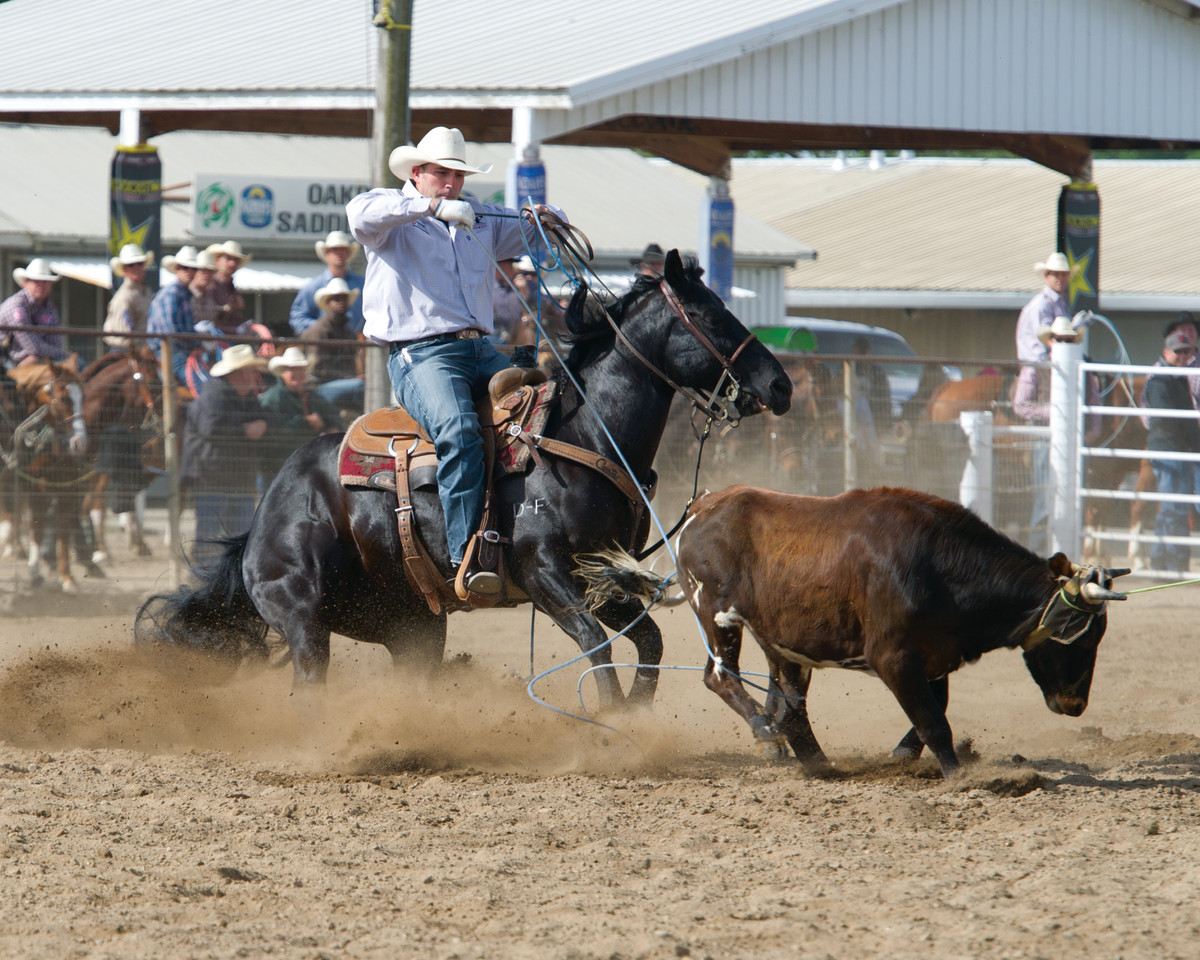A cow horse is a cow horse is a cow horse.
At least, that was true in the old days. But as the sport of team roping has exploded, so have the nuances in breeding, causing heelers to increasingly look to the cutting industry for the brightest shining stars.
Case in point: The three best heel horses in the rodeo world in the last decade—Jake Long’s Colonel, Billie Jack Saeben’s Kevin, and Brady Minor’s Sug—pack the blood of Colonel Freckles, Peppy San, Doc O’Lena and High Brow Hickory. For the record, the latter sired cutting legend High Brow Cat, whose offspring have earned $93 million … and counting.
High Brow Cat is the second-most valuable Quarter Horse stallion of all time because his get are cow-smart, quick-footed, can crawl on their bellies, and have huge stops. What more could you want in a heel horse?
At 25, High Brow Cat himself sold to an investment firm helmed by Darren Blanton—a 4 header—for what the Wall Street Journal approximates was just under $10 million (the sale also included a clone—Copy Cat—and a 500-acre Texas ranch).
Rope-horse training icon and 21-time NFR qualifier J.D. Yates never dreamed of this kind of market, but he also never thought amateur jackpotters would be winning the kind of money they’re raking in today.
Proof in Papers
Cow-horse blood is nothing new in the world’s best rope horses.
Like High Brow Cat, Patrick Smith’s gold-buckle sorrel, Amigo, and Martin Lucero’s great Spiderman were both grandsons of Docs Hickory. Hollywood Gold dotted the papers of Kyle Lockett’s Dinero and Rich Skelton’s Chili Dog. Dinero and Kory Koontz’s legendary Iceman both sported Hall-of-Famer Mr. Gun Smoke on the top side.
Colonel Freckles has been king a long time—he shows up in the blood of Jake Long’s Horse of the Year, Colonel, and Jade Corkill’s two-time PRCA Horse of the Year, Cave Man. Another mainstay has been Doc O’Lena. Though thought too small as a yearling to train for cutting, when someone finally did, he said the horse trained himself, and Doc O’Lena went on to sweep all four go-rounds at the NCHA Futurity.
“I think cutting breeding makes rope horses more cow-smart,” NFR heeler Joseph Harrison said. “It helps if a rope horse is able to read a cow better.”
That’s one of the reasons NFR heeler Dean Tuftin, whose family showed cow horses at the Canadian version of the Snaffle Bit Futurity, stands a trio of cutting-bred stallions at DT Horses.
“I was sold on the fact that the cow horses are broke, athletic, and near what we needed to make great rope horses,” said Tuftin.
One of his stallions is by NCHA Futurity champ Metallic Cat out of Sweet Little CD by CD Olena—a former NCHA Futurity champ and the sire of two PRCA Heel Horses of the Year: Brady Minor’s Dugout and Ryan Motes’ Starbucks.

“He timed steers really well; reads them perfectly when they switch,” Motes said of Starbucks.
The Texas heeler has been aboard cutters ever since the Dual Pep horse he rode his rookie year. His mother, Danny Motes, stands the world champion cutter CD Lights by CD Olena; and Ryan and his wife, Courtney, own a Dual Rey mare. Plus, he’s bringing along 5-year-old heel horses by CD Lights and Metallic Cat.

“Their advantage is not only their ‘cow,’ but their demeanor,” he said.
Pros and cons
For years, there were virtually no rope-horse breeders, meaning heelers (luckily) ended up with cutting and reining rejects.
“They already have a huge stop and can read a cow,” said rope-horse trainer and AQHA world champ Clay Logan, who’s been converting cutting horses since 1999 via Clay Logan Performance Horses. “And, they’re so broke and well-trained.”
Logan mostly trains former cutting prospects because he gets along better on cutters than reiners, although it should be pointed out that Minor’s other two-time PRCA Heel Horse of the Year, Rey, is reining-bred on both sides (Topsail Whiz and Shining Spark), and is a grandson of the great cutting mare Reylena.
“I feel like horses started in reining programs carry their heads lower and haven’t had as much handle put on them,” Logan said. “Cutting trainers move their feet a lot and also use their hands. If you want to send one of those horses somewhere, it knows how to follow its nose and continue with its feet. For me, that takes a lot of steps out of the way, so I don’t need to go back and get one re-broke to where it will follow its nose or rate a cow.”
But Logan did say he’s pleased with some reining prospects he picked up as long 2-year-olds.
Two-time NFR heeler and trainer for Dixon Flowers Rope Horses Billie Jack Saebens also doesn’t mind a 2-year-old culled from a reining program. He says that’s a colt with a really good start that isn’t bred to be quite as “watchy” with a cow, but isn’t far enough along to have the low-headed reining handle that doesn’t work for team ropers.
Timing is important if you plan on poaching from a cutting or reining program. Getting one early means ensuring hocks and stifles are still in good shape. Plus, when it comes to prospects whose blood seeps with “cow,” less is more. A heeling prospect drilled too long in cutting can step off to the inside too much on the corner. That horse needs to be repositioned and taught to hold its shoulders up.
“It’s hard to fix,” said Yates. “Let’s face it, since they were 2, they were trained to get to the head, stop, and turn. In heeling, one place you don’t want them to go is the head.”
If you’re handy like Logan or Harrison, who trains for Bobby Lewis Quarter Horses, you can get by it. Harrison’s legendary NFR heel horse, Mainstreet Boon (by Peptoboonsmal out of a Freckles Playboy/Doc O’Lena mare), was cut on for about three years. Another mare he campaigned, Lula Dual, first won a reserve national championship in the reined cow-horse genre.
“I’ve had some that I couldn’t get completely over it,” said Harrison. “But others get it figured out, and when they do, they’re a whole lot of fun.”
Saebens’ first rodeo horse earned reined cow-horse money before Logan trained her a decade ago. The flashy sorrel, Gunna Be A Legend, by a son of Smart Little Lena out of a Mr. Gun Smoke granddaughter, taught Saebens what can happen when cutters are turned loose on Corrientes.
“It was really fun to get on her and cut,” Saebens said. “But it got her watching too much and it would take me a week to be able to get her good to heel again.”
One caveat of cutting breeding is that the latest superstars aren’t bred to be very big. The best roping prospects, then, are horses too big to get across the pen or not quite cowy enough to make cutting trainers happy. That’s where Logan’s great heel horse, Replay Blue Boon, comes in.
“He didn’t have enough cow, but had plenty of stop, and was plenty strong,” Logan said. “You kind of had to beat him up to make him cut.”
Replay, now 16, is by Dual’s Blue Boon, out of the same dam as Peptoboonsmal (she was cloned, if that tells you what kind of blood runs through Replay). The blue roan former cutter is an AQHA world champ and has been heeled on at RodeoHouston and the BFI. Like most cutters, Replay only stands 14.2, but he’ll weigh close to 1,200 pounds.
Motes said CD Lights stands just under 14.2, but tends to produce good-sized colts with some speed. For feel, Motes prefers a bigger heel horse, so he likes Starbucks’ bald-faced younger brother, CD Rockstar, who stands 15 hands. While Yates also prefers a nice 15-hand, good-strided rope horse that’ll “be with you a long time,” Harrison prefers his to stand about 14.3.
“If one is 15 or 15.1 hands,” he said, “they don’t have a tight enough stride to be able to correct as well. And most of those horses that are only 14.1 or 14.2, for me, their stride is a little too tight to where you can’t match them with your swing.”
This is not quite the case for one of the world’s best heel horses: former runner-up PRCA Heel Horse of the Year Domino Lena, or “Kevin.”
“He might only be 14 hands,” Saebens said of Kevin, who’s out of a daughter of reining supersire Grays Starlight. “But I bet he weighs 1,200. Most guys need to ride 10 feet wide; I can ride 5 feet wide because he’s so short-strided and quick. I can see the steer’s feet anywhere, because his neck’s only a foot and a half long!”
Surprisingly, speed has not been a factor with Kevin—also a former Heel Horse of the BFI.
“I didn’t know if he’d be fast enough,” Saebens said. “But that horse has been fast enough everywhere—at the National Finals and at Cheyenne. He’s fast enough in every situation.”
Sourcing smarts
So where to go for some of this horseflesh?
“If you look around on the Internet, there are several ranches raising some nice colts,” Yates said. “They’re not all 100-percent cutting-bred; but if they are 100-percent cutting, a lot of those are too small to rope on.”
To get good culls direct from cutting and reining trainers, word-of-mouth is the best way. Consider places like North Texas a double-edged sword—there are more horses for higher prices.
“Cutting is so competitive down here that if you’re looking for that lifetime-type horse, you can find a really nice 3-year-old that won’t make the cutting futurity,” Motes said. “Or, out in Wyoming or California, you might more easily find some 5-year-olds with a little less cutting training that are still reasonably priced.”
If scouting AQHA trainers, talk to some who don’t over-specialize and do some cowhorse work and cut, or do sorting and rope both ends. Well-rounded horses fall into the discipline they’re best at.
Reputation means something, too. In addition to Gunna Be A Legend, Dixon Flowers got Saebens’ Kevin through Logan, who also trained Minor’s Dugout. Ask Open ropers which trainers they trust to sell horses that are what they say.
You can also check out auctions such as the Winter Premier Sale preceding the World’s Greatest Horseman Finals each February, or the Legacy Reining Breeders Sale every October, and NCHA Futurity sales each December, all in North Texas.
But, Saebens warns, don’t get stuck on particular bloodlines. Buy for demeanor and individual traits. And, Harrison says, don’t compromise just for bigger size, because that can lead to prospects that are “bad-minded and slow-footed.”
Yes, prospects with cow-horse breeding come with value-added prices, but the increased demand for head and heel horses today means the world’s best trainers are riding prospects a little longer, even if they won’t make Open horses.
“I need a horse that can outrun the head rope,” Harrison said. “But most 5 heelers just want the potential. There are some really good young horses out there now that maybe aren’t seasoned enough for a #15 or Open roping, but are so good-minded.”
In fact, Motes loves the way the new rope-horse futurities are giving trainers a place to season young heel horses that aren’t yet ready for full-on jackpotting or rodeoing. That’s good news for those of you who want today’s “cow horse” to become your next calm-scoring, hard-running, belly-crawling, big-stopping heel horse.
“Futurities are the best thing in the world for these guys going to World Series ropings,” Yates said. “Let me ride a 4-, 5-, or 6-year-old and by the time he turns 7, you’re going to want him.”
Brought to you by Sentinel Horse Nutrition.









